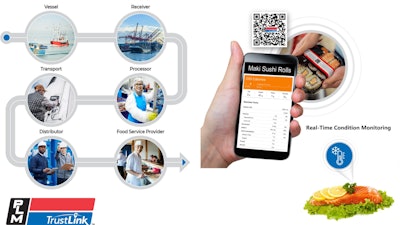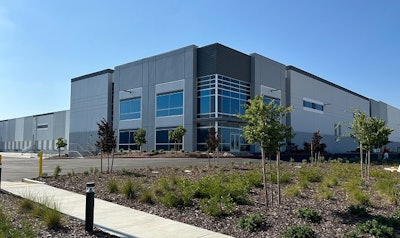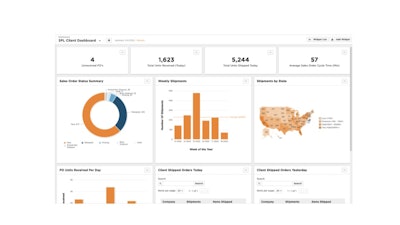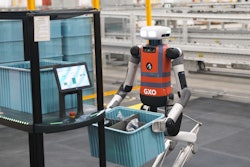![Top Supply Chain Project 2024 Vertical [color]](https://img.sdcexec.com/files/base/acbm/scn/image/2024/04/Top_Supply_Chain_Project_2024_vertical__color_.6615867db5fc2.png?auto=format%2Ccompress&q=70&w=400)
From demand planning and forecasting to implementing the ultimate in warehouse automation, the past 12 months has seen companies within the supply chain and logistics space upgrade, enhance, adopt and adapt in order to achieve greater efficiency along the chain.
Companies partnered to implement each others' software and technology and work smarter, together.
And, it's these partnerships that have cultivated resilience and placed a spotlight on projects designed to make the supply chain space safer and more efficient.
And, now it's time to celebrate those projects!
Meet the winners of this year's Top Supply Chain Projects award.
This year's supply chain projects focused on sustainability, automation, streamlining manual processes, enhancing traceability, mitigating risk and optimizing the overall supply chain.
NEW THIS YEAR: This award is now open to all categories/markets within the Supply & Demand Chain Executive AND Food Logistics audience, which includes the cold food chain.
CLICK HERE to learn more about all of our winners.
ALSO NEW THIS YEAR: There is one overall winner for the Food Logistics audience and one overall winner for the Supply & Demand Chain Executive audience, in addition to the regular winners.
Overall winner for Food Logistics
 PLM Fleet's PLM TrustLink was selected based on its cloud-based IoT platform.PLM Fleet
PLM Fleet's PLM TrustLink was selected based on its cloud-based IoT platform.PLM Fleet
PLM Fleet LLC
www.plmfleet.com
Sector: Transportation/technology
Customer client: The Ohio State University
About the project: The overall objective of the project was to collect information and identify opportunities for improvements in sustainability of the frozen mango supply chain. This project, which was done in collaboration with a major international food supplier and a U.S. grocery retailer, involved the collection of data at all locations of frozen mango supply chain, from harvest of the mango until delivery to the consumer. The data needed for Life Cycle Assessments (LCA) was collected during at least 12 phases between production in Peru and delivery of frozen mango to a location in Midwest U.S. The three specific objectives were: (1) to monitor the frozen food mango supply chain from production of the fresh mango through delivery of the frozen mango to the consumer, (2) to conduct a thermal energy analysis of freezing operations for mango, with specific attention to individual-quick-freezing (IQF), and (3) to conduct an LCA of the supply chain for frozen mango.
Solution: Pilot findings detail the LCA, resource depletion potential (RDP), and the global warming potential (GWP) of food products, all attributes needed to measure climate and sustainability goals. PLM TrustLink was selected based on its cloud-based IoT platform. Features consist of comprehensive condition-monitoring track-and-trace solutions, delivering transparency from origin to destination and providing real-time actionable data on critical tracking events, temperature visibility, inventory counts, item location features, systems integrations and more. This project phase focused on the sensitivity of frozen mango to temperature deviations, as a first step in considering the opportunities for reducing energy demand by accepting storage temperatures slightly above the accepted standard of -18°C. Experimental data for all phases of the frozen mango supply chain were collected and analyzed. Mango freezing operations in Peru and in Thailand were included in the project. Frozen mango from the operation in Peru was exported to the United State and monitored from the time/location of the freezing operation through transport to warehouse storage and re-packaging, and eventually, to a consumer retail outlet.
Results: The focus for the third phase of the project was on the storage, transportation and distribution of the frozen mango. The supply chain for frozen mango to the United States required nearly six months, after freezing operations in April 2023 and delivery to the Midwest in November 2023. The supply chain included ocean vessel and transportation by refrigerated trucks within the United States. The temperature of the frozen mango was consistently within the -20°C to -10°C temperature range, with only two brief deviations. The potential for resource reductions exists at the location of product freezing. Opportunities to reduce RDP and GWP exist throughout the supply chain. The reduction of time at any stage of the supply chain would reduce the demand for resources. In addition, such steps would reduce the potential of any type of thermal abuse with impact on product quality.
CLICK HERE to watch the exclusive video interview with Don Durm, VP, customer solutions for PLM Fleet.
Overall winner for the Supply & Demand Chain Executive
 Agility Robotics and GXO partnered to test “Digit,” a humanoid robot, in SPANX’s facility in Flowery Branch, Ga.GXO Logistics
Agility Robotics and GXO partnered to test “Digit,” a humanoid robot, in SPANX’s facility in Flowery Branch, Ga.GXO Logistics
GXO Logistics, Inc.
www.gxo.com
Sectors: Contract logistics, warehousing, supply chain, warehouse management
Customer client: GXO Logistics' manufacturing site for SPANX
About the project: GXO Logistics partnered with Agility Robotics to reduce repetitive tasks and heavy lifting inside GXO's SPANX warehouse.
Solution: Agility Robotics and GXO partnered to test “Digit,” a humanoid robot, in SPANX’s facility in Flowery Branch, Ga., where GXO manages warehouse operations for the global womenswear brand’s direct-to-consumer and in-store orders. The pilot focused on training Digit to undertake repetitive tasks such as removing totes from autonomous mobile robots (AMRs) and placing them onto conveyors. A key component of the pilot was evaluating numerous KPIs to help Agility further develop and improve the technology. Digit, which is 5'9" tall, weighs 140 pounds and can lift up to 35 pounds, is designed to work in human spaces and can be easily adapted to various warehouse tasks through software updates.
Results: The pilot was more about learning and improving for the future than anything else. GXO provided feedback that helps advance this technology, looking at everything from efficiency and accuracy to battery life, safety and employee feedback. The positive feedback from GXO employees details how automation can perform repetitive tasks with speed and precision, while working with associates to provide a better workplace.
CLICK HERE to watch the exclusive video interview with Adrian Stoch, chief automation officer at GXO Logistics.
CLICK HERE to learn more about all of our winners.
 ALOM began the buildout of a new 170,000-square-foot battery storage center in Sacramento, Calif.ALOM
ALOM began the buildout of a new 170,000-square-foot battery storage center in Sacramento, Calif.ALOM
ALOM
www.alom.com
Sectors: Medical/lifesciences, technology, utility/energy, highly regulated industries
Customer client: ALOM
About the project: Warehouse facilities that store products containing batteries, specifically lithium-ion batteries, must be designed and have proper permits showing they meet an increasing number of regulatory requirements, most notably, charge monitoring, heat detection, fire suppression/containment, and labeling/signage. The challenge for ALOM is how to increase warehouse storage capacity for products containing lithium-ion batteries while meeting full fire code, workplace safety, insurance, and regulatory compliance requirements. Designing, implementing, monitoring and maintaining these required safety measures and control systems is a high-cost investment.
Solution: Beginning in Q3 2023, ALOM began the buildout of a new 170,000-square-foot storage, production and fulfillment center in Sacramento, Calif. This presented an ideal opportunity to design and implement a new construction (vs. retrofit existing warehouse space) state-of-the-art battery storage facility. Scheduled to open in September, and currently in the permitting phase, the battery storage area will provide 1,460 pallet storage locations and include 2-hour rated firewalls completely surrounding the storage area, 2-hour fire-rated roll up steel door(s), VESDA air sampling and early stage heat and smoke detection system, overhead and in-rack (front facing) sprinkler system, 12-guage sheet metal storage rack separation, temperature-controlled and monitored storage area. It is the goal for this storage facility to have adequate capacity for ALOM to add additional battery storage and fulfillment programs over the next 3-5 years, and to serve as a blueprint for increased battery-rated storage capacity at additional locations as required.
Results: ALOM is forecasting that the revenue growth the company will gain as result of providing customers with safety-rated and available battery storage capacity at the Sacramento facility will increase 5 times in 24 months over the $1 million build-out investment. Automotive EV, residential and commercial EV charge station, E-bike, home power storage, and a growing list of products are coming onto the market that will increase the need and demand for “safety-rated” warehouse capacity suitable to handle and store high volumes of products containing battery technology. The business impact is expected $5 million in battery program business growth over 24 months following Q3-4 2024 launch.
 Alogistico turned to Deposco for a a flexible, cloud-based WMS.Deposco
Alogistico turned to Deposco for a a flexible, cloud-based WMS.Deposco
Deposco
https://deposco.com
Sectors: Software/services such as warehouse management system, order management, distributed order management
Customer client: Alogistico
About the project: On Dec. 21, 2023, Alogistico received 375,000 eaches of swimwear for a client, but the cartons were a mess. Packages had been opened, no weights were supplied, and they had no way to get a mass update. Alogistico needed a flexible, cloud-based WMS.
Solution: Deposco worked with Alogistico through Christmas Eve to get the receipts in the system in an incredible timeframe, which enabled the company to ship their first orders on Dec. 27. They went live on Dec. 28, and the first week of full inbound/outbound, they shipped 1,000 orders.
Results: Swimwear was just the beginning. Over the next three months, Desposco enabled multiple wins for Alogistico, including: +15 days, wholesale EDI deployed, allowing Alogistico to start shipping orders for REI, selling Amazon aggregator products, and supporting all kinds of orders; +30 days, productivity doubled; +45 days, custom dashboards were live, showing productivity tracking and analysis of product dynamics. By Day 75, Alogistico had a $3 million business on track to double its run rate in about six months from Day 1. Alogistico credits their success to the responsiveness of Deposo’s team, swift delivery (a couple of weeks for deliverables), face-to-face support, and the ability to match how their business operates.
 Lazer Logistics partnered with a CPG client to develop an EV roadmap.Lazer Logistics
Lazer Logistics partnered with a CPG client to develop an EV roadmap.Lazer Logistics
Lazer Logistics
www.lazerlogistics.com
Sectors: Logistics, supply chain, transportation, technology
Customer client: CPG company
About the project: In 2017, one of Lazer’s largest customers, a leading multinational CPG company, reached out to Lazer for help on a sustainability project involving one of their food processing plants located in Illinois. Lazer was tasked with converting the CPG company's diesel spotter fleet to EVs.
Solution: Heading into 2023, the CPG company wanted to expand its sustainability program, and once again, reached out to Lazer Logistics to work out a solution. Together, they developed an EV roadmap that included implementing Lazer Logistics’ EV program at six North American facilities and in Canada in 2023.
Results: Through the implementation of Lazer Logistics’ EVs and sustainability program at the six new locations in 2023, the company continued to make strides toward its global goals in reducing the carbon footprint of transportation operations. This included avoiding 52,000 gallons of diesel consumption, 34,000 zero-emission key-on hours, and 64,000 zero-emissions miles. This translated into reducing 1.1 million pounds of CO2, equivalent to the environmental impact of removing 119 gasoline-powered passenger cars from the road for a year, not driving 1.2 million gasoline-powered passenger car miles and enough electricity to power 98 homes for a year.
CLICK HERE to learn more about all of our winners.














